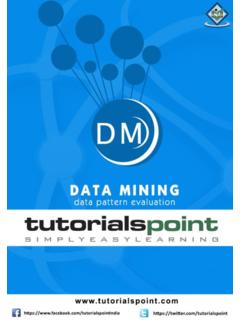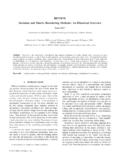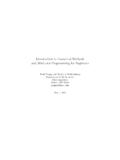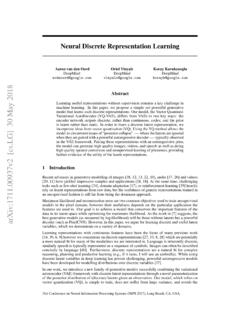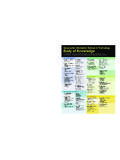Transcription of Algorithms and Data Structures - Oberon
1 5 Algorithms and data Structures N. Wirth 1985 ( Oberon version: August 2004) Contents Preface 1 Fundamental data Structures Introduction The Concept of data Type Primitive data Types Standard Primitive Types Integer types The type REAL The type BOOLEAN The type CHAR The type SET The Array structure The Record structure Representation of Arrays, Records, and Sets Representation of Arrays Representation of Recors Representation of Sets The File (Sequence) Elementary File Operators Buffering Sequences Buffering between Concurrent Processes Textual Input and Output Searching Linear Search Binary Search Table Search Straight String Search The Knuth-Morris-Pratt String Search The Boyer-Moore String Search Exercises 2 Sorting Introduction Sorting Arrays Sorting by Straight Insertion Sorting by Straight Selection Sorting by Straight Exchange Advanced Sorting methods Insertion Sort by Diminishing Increment Tree Sort Partition Sort Finding the Median A Comparison of Array Sorting methods Sorting
2 Sequences Straight Merging Natural Merging Balanced Multiway Merging Polyphase Sort Distribution of Initial Runs Exercises 6 3 Recursive Algorithms Introduction When Not to Use Recursion Two Examples of Recursive Programs Backtracking Algorithms The Eight Queens Problem The Stable Marriage Problem The Optimal Selection Problem Exercises 4 Dynamic Information Structures Recursive data Types Pointers Linear Lists Basic Operations Ordered Lists and Reorganizing Lists An Application: Topological Sorting Tree Structures Basic Concepts and Definitions Basic Operations on Binary Trees Tree Search and Insertion Tree Deletion Analysis of Tree Search and Insertion Balanced Trees Balanced Tree Insertion Balanced Tree Deletion Optimal Search Trees B-Trees Multiway B-Trees Binary B-Trees Priority Search Trees Exercises 5 Key Transformations (Hashing)
3 Introduction Choice of a Hash Function Collision handling Analysis of Key Transformation Exercises Appendices A The ASCII Character Set B The Syntax of Oberon Index 7 Preface In recent years the subject of computer programming has been recognized as a discipline whose mastery is fundamental and crucial to the success of many engineering projects and which is amenable to scientific treatement and presentation. It has advanced from a craft to an academic discipline. The initial outstanding contributions toward this development were made by Dijkstra and Hoare.
4 Dijkstra's Notes on Structured Programming [1] opened a new view of programming as a scientific subject and intellectual challenge, and it coined the title for a "revolution" in programming. Hoare's Axiomatic Basis of Computer Programming [2] showed in a lucid manner that programs are amenable to an exacting analysis based on mathematical reasoning. Both these papers argue convincingly that many programmming errors can be prevented by making programmers aware of the methods and techniques which they hitherto applied intuitively and often unconsciously.
5 These papers focused their attention on the aspects of composition and analysis of programs, or more explicitly, on the structure of Algorithms represented by program texts. Yet, it is abundantly clear that a systematic and scientific approach to program construction primarily has a bearing in the case of large, complex programs which involve complicated sets of data . Hence, a methodology of programming is also bound to include all aspects of data structuring. Programs, after all, are concrete formulations of abstract Algorithms based on particular representations and Structures of data .
6 An outstanding contribution to bring order into the bewildering variety of terminology and concepts on data Structures was made by Hoare through his Notes on data Structuring [3]. It made clear that decisions about structuring data cannot be made without knowledge of the Algorithms applied to the data and that, vice versa, the structure and choice of Algorithms often depend strongly on the structure of the underlying data . In short, the subjects of program composition and data Structures are inseparably interwined. Yet, this book starts with a chapter on data structure for two reasons.
7 First, one has an intuitive feeling that data precede Algorithms : you must have some objects before you can perform operations on them. Second, and this is the more immediate reason, this book assumes that the reader is familiar with the basic notions of computer programming. Traditionally and sensibly, however, introductory programming courses concentrate on Algorithms operating on relatively simple Structures of data . Hence, an introductory chapter on data Structures seems appropriate. Throughout the book, and particularly in Chap.
8 1, we follow the theory and terminology expounded by Hoare and realized in the programming language Pascal [4]. The essence of this theory is that data in the first instance represent abstractions of real phenomena and are preferably formulated as abstract Structures not necessarily realized in common programming languages. In the process of program construction the data representation is gradually refined -- in step with the refinement of the algorithm -- to comply more and more with the constraints imposed by an available programming system [5].
9 We therefore postulate a number of basic building principles of data Structures , called the fundamental Structures . It is most important that they are constructs that are known to be quite easily implementable on actual computers, for only in this case can they be considered the true elements of an actual data representation, as the molecules emerging from the final step of refinements of the data description. They are the record, the array (with fixed size), and the set. Not surprisingly, these basic building principles correspond to mathematical notions that are fundamental as well.
10 A cornerstone of this theory of data Structures is the distinction between fundamental and "advanced" Structures . The former are the molecules -- themselves built out of atoms -- that are the components of the latter. Variables of a fundamental structure change only their value, but never their structure and never the set of values they can assume. As a consequence, the size of the store they occupy remains constant. "Advanced" Structures , however, are characterized by their change of value and structure during the execution of a program.
